General News
Neuro Image Analysis Team Joins SCI Institute
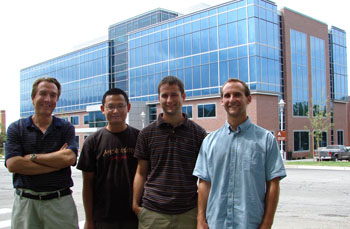 (L-R) Dr. Guido Gerig, Dr. Marcel Prastawa, Casey Goodlett, Sylvain Gouttard |
SCI to Collaborate on Three New SciDAC Centers
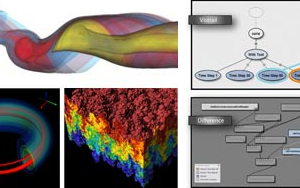 The SCI Institute is pleased to announce that it will be participating in three DOE SciDAC 2 research centers.
The SCI Institute is pleased to announce that it will be participating in three DOE SciDAC 2 research centers.The Visualization and Analytics Center for Enabling Technologies (VACET), includes SCI Institute faculty Chris Johnson (Center Co- PI with Wes Bethel from LBNL), Chuck Hansen, Steve Parker, Claudio Silva, Allen Sanderson and Xavier Tricoche. The center will focus on leveraging scientific visualization and analytics technology to increase scientific productivity and insight. It will be challenged with resolving one of the primary bottlenecks in contemporary science, making the massive amounts of data now available to scientists accessible and understandable. Advances in computational technology have resulted in an "information Big Bang," vastly increasing the amount of scientific data available, but also creating a significant challenge to reveal the structures, relationships, and anomalies hidden within the data. The VACET Center will respond to that challenge by adapting, extending, creating when necessary, and deploying visualization and data understanding technologies for the scientific community.
SCI Grad Student Helps Solve Open Problem in Computational Geometry
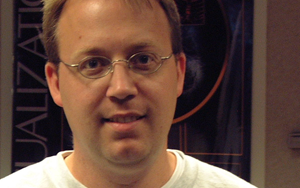 SCI graduate student Jason F. Shepherd and coauthor Carlos D. Carbonera have published a solution to Problem #27 of The Open Problems Project's list of unresolved problems in computational geometry. The question is:
SCI graduate student Jason F. Shepherd and coauthor Carlos D. Carbonera have published a solution to Problem #27 of The Open Problems Project's list of unresolved problems in computational geometry. The question is:
Can the interior of every simply connected polyhedron whose surface is meshed by an even number of quadrilaterals be partitioned into a hexahedral mesh compatible with the surface meshing?The solution of Carbonera and Shepherd settles the practical aspects of the problem by demonstrating an explicit algorithm that extends a quadrilateral surface mesh to a hexahedral mesh where all the hexahedra have straight segment edges. This work did leave one aspect of the problem open. The authors did not resolve the question of achieving a hexahedral mesh with all planar faces. The collaborators are now working on a revision that should close this problem definitively.
C. D. Carbonera, J.F. Shepherd, "A Constructive Approach to Constrained Hexahedral Mesh Generation," Proceedings, 15th International Meshing Roundtable, Birmingham, AL, September 2006.
Dr. Sarang Joshi joins SCI Institute
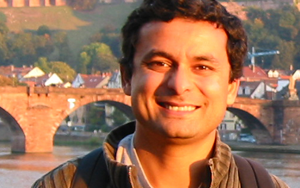 Dr. Sarang Joshi has joined SCI as an Associate Professor of the Department of Bio Engineering. Before coming to Utah, Dr. Joshi was an Assistant Professor of Radiation Oncology and an Adjunct Assistant Professor of Computer Science at the University of North Carolina in Chapel Hill. Prior to joining Chapel Hill, Dr. Joshi was Director of Technology Development at IntellX, a Medical Imaging start-up company which was later acquired by Medtronic. Sarang's research interests are in the emerging field of Computational Anatomy and have recently focused on its application to Radiation Oncology. Most recently he spent a year on sabbatical at DKFZ (German Cancer Research Center) in Heidelberg, Germany, as a visiting scientist in the Department of Medical Physics where he focused on developing four dimensional radiation therapy approaches for improved treatment of Prostate and Lung Cancer.
Dr. Sarang Joshi has joined SCI as an Associate Professor of the Department of Bio Engineering. Before coming to Utah, Dr. Joshi was an Assistant Professor of Radiation Oncology and an Adjunct Assistant Professor of Computer Science at the University of North Carolina in Chapel Hill. Prior to joining Chapel Hill, Dr. Joshi was Director of Technology Development at IntellX, a Medical Imaging start-up company which was later acquired by Medtronic. Sarang's research interests are in the emerging field of Computational Anatomy and have recently focused on its application to Radiation Oncology. Most recently he spent a year on sabbatical at DKFZ (German Cancer Research Center) in Heidelberg, Germany, as a visiting scientist in the Department of Medical Physics where he focused on developing four dimensional radiation therapy approaches for improved treatment of Prostate and Lung Cancer.Dr. Joshi received his D.Sc. in Electrical Engineering from Washington University in St. Louis. His research interests include Image Understanding, Computer Vision and Shape Analysis. He holds numerous patents in the area of image registration and has over 50 scholarly publications.
Steve Corbató Named Associate Director of the Scientific Computing and Imaging Institute
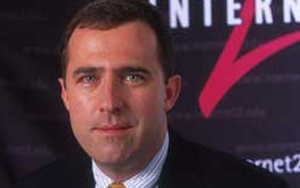 Steve Corbató has joined the University of Utah's Scientific Computing and Imaging (SCI) Institute as its Associate Director. The Scientific Computing and Imaging (SCI) Institute has established itself as an international research leader in the areas of scientific computing, scientific visualization, and imaging, and in this new position Steve will help lead more than 100 faculty, staff and students in pursuing innovative, ground-breaking research and development aimed at solving important problems in science, engineering, and medicine.
Steve Corbató has joined the University of Utah's Scientific Computing and Imaging (SCI) Institute as its Associate Director. The Scientific Computing and Imaging (SCI) Institute has established itself as an international research leader in the areas of scientific computing, scientific visualization, and imaging, and in this new position Steve will help lead more than 100 faculty, staff and students in pursuing innovative, ground-breaking research and development aimed at solving important problems in science, engineering, and medicine.Steve most recently served as Managing Director for Technology Direction and Development at Internet2, a non-profit, university-led consortium focused on developing and deploying advanced Internet technologies. In that role, he oversaw a broad portfolio of initiatives in high-performance networking, middleware, network diagnostics, and security. He also worked to develop overall strategy and key relationships for Internet2's next generation of network infrastructure.
SCI Institute Welcomes New Faculty
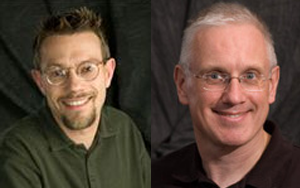 Mike Kirby joins us from Brown University.The focus of his research focus deals with large- scale scientific computing and visualization, with an emphasis on the scientific cycle of mathematical modeling, computation, visualization, evaluation, and understanding. His primary research interests are: Computational Science and Engineering, Concurrent Programming, Scientific Visualization, Interdisciplinary Collaboration across Computer Science, Engineering, Applied Math, Computational Steering, and High Performance Computing.
Mike Kirby joins us from Brown University.The focus of his research focus deals with large- scale scientific computing and visualization, with an emphasis on the scientific cycle of mathematical modeling, computation, visualization, evaluation, and understanding. His primary research interests are: Computational Science and Engineering, Concurrent Programming, Scientific Visualization, Interdisciplinary Collaboration across Computer Science, Engineering, Applied Math, Computational Steering, and High Performance Computing.Martin Berzins joins us from the University of Leeds where he is also Professor of Scientific Computing, Co-director of the Computational PDEs Unit, and head of the Scientific Computing and Visualization research group. His primary interests are in the fields of Adaptive Numerical Methods and software, Unstructured Tetrahedral Meshes, Reacting Flows, Time Dependent PDEs, Parallel Algorithms, and Computational Fluid and Solid Mechanics Applications.
First Year ESP Recipients Walk at Graduation
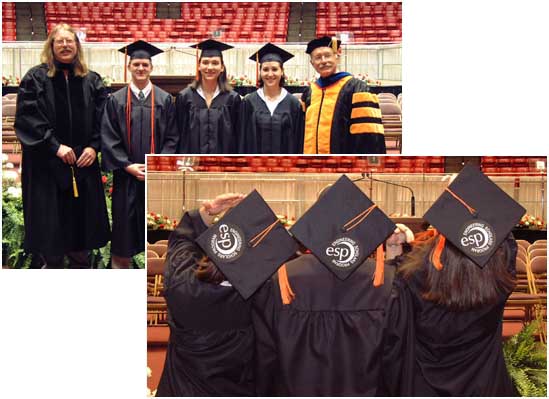 Pictured here are three of our first year scholarship recipients of the Undergraduate Engineering Scholars Program who walked at graduation this May. Darby J Van Uitert, Scott Little, and Rebecca Bott received their degrees from the University of Utah College of Engineering in Computer Science, Electrical Engineering, and Bioengineering respectively.
Pictured here are three of our first year scholarship recipients of the Undergraduate Engineering Scholars Program who walked at graduation this May. Darby J Van Uitert, Scott Little, and Rebecca Bott received their degrees from the University of Utah College of Engineering in Computer Science, Electrical Engineering, and Bioengineering respectively.Established in 1999 by Chris Johnson and the College of Engineering, the Engineering Scholars Program is a scholarship opportunity for incoming freshmen interested in aspects of engineering and computer science. The quest of the ESP is to leverage the exciting engineering-based research at the University by exposing the first year students to actual research activities. The addition of a research component to the first year student's experience allows the student to see over the horizon offered by prerequisite courses. By giving the first year student a more in-depth look into engineering we propose to increase the enthusiasm level of the students with the result being significantly improved retention rates. Higher retention rates translate into a larger and better-trained graduating class of much-needed engineers and computer scientists.
These students are the best and brightest with an average GPA of 3.96 and an average ACT score of 31. Now in its fourth year, the number of scholarship recipients has increased from nine in 1999 to fifteen in 2002.
SCI Undergrads Present Before State Legislature
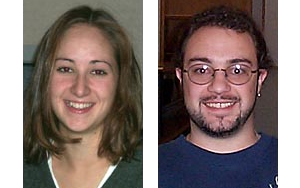 Two SCIers, Darby Brown and Jesse Hall, were given a rare opportunity to showcase their work before the Utah State Legislature on January 18th. In conjunction with a University wide effort to show the benefits of undergraduate studies within a research institution, Darby and Jesse, both undergraduate members of the Scientific Computing and Imaging Institute, along with thirteen other students, made a poster presentation before the newly elected legislature.
Two SCIers, Darby Brown and Jesse Hall, were given a rare opportunity to showcase their work before the Utah State Legislature on January 18th. In conjunction with a University wide effort to show the benefits of undergraduate studies within a research institution, Darby and Jesse, both undergraduate members of the Scientific Computing and Imaging Institute, along with thirteen other students, made a poster presentation before the newly elected legislature.“This is a great opportunity for both students and University alike,” says Ronald J.Pugmire. Associate Vice President for Research. “Not only are we given the opportunity to show off our undergraduate programs, but the students are given both the chance to represent their research to their elected officials as well as an early glimpse into the collaboration of education and government.”
SCI Institute Appeals to Local Business Leadership for Increases In State Funding
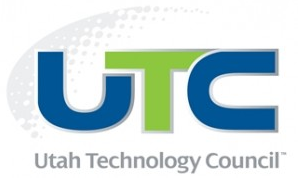 On January 17th Dr. Christopher Johnson, director of the SCI Institute, appealed to local information technology business leaders to assist in lobbying the Utah State Legislature for more funding for Engineering disciplines. Dr. Johnson presented an overview of the current research within the Institute with an emphasis on medicine.
On January 17th Dr. Christopher Johnson, director of the SCI Institute, appealed to local information technology business leaders to assist in lobbying the Utah State Legislature for more funding for Engineering disciplines. Dr. Johnson presented an overview of the current research within the Institute with an emphasis on medicine.He described the history of biomedical devices from EEG to MRI. The talk also included the story of a real patient treated in part with technology developed here at the SCI Institute. Dr. Johnson described the case of Sarah, a child diagnosed with a tumor near the top of her spinal column. In such cases, doctors are only able to see sets of two-dimensional slices generated from an MRI. The physician must then reconstruct a three-dimensional image from those slices. Using technology developed at the SCI Institute, the team of physicians was not only able to see the tumor in full three-dimensions, but they were also able to use stereo glasses to “virtually” maneuver inside of the MRI. The combination of these technologies gave the surgeons a much clearer visualization and persuaded them to alter how they were going to operate.
SCI Institute Hosts Governor to Launch Ambitious Engineering Educational Initiative
 On March 19th, Governor Michael Leavitt visited the SCI Institute for a bill signing ceremony that marks the launch of an ambitious initiative to double the number of engineering and technology graduates over the next five years. The law provides funding for new faculty, pay increases, student loans, and infrastructure improvements. Most notably, it provides $15 million in matching funds for the construction of a new engineering building as well as $5 million for remodeling of the current Merrill Engineering Building. The new building will go directly north of the MEB. Gerald Stringfellow, the dean of the U of U College of Engineering, will be challenged to raise an additional $13 million in order to get the funding. Surrounded by students and some of the state's top political leaders, Gov. Leavitt discussed the importance of the new law. “This initiative is an essential step toward accelerating Utah's growth as a technology center,” he said. “It will help employers who face a critical shortage of engineers, and it will provide high-paying jobs for our children.”
On March 19th, Governor Michael Leavitt visited the SCI Institute for a bill signing ceremony that marks the launch of an ambitious initiative to double the number of engineering and technology graduates over the next five years. The law provides funding for new faculty, pay increases, student loans, and infrastructure improvements. Most notably, it provides $15 million in matching funds for the construction of a new engineering building as well as $5 million for remodeling of the current Merrill Engineering Building. The new building will go directly north of the MEB. Gerald Stringfellow, the dean of the U of U College of Engineering, will be challenged to raise an additional $13 million in order to get the funding. Surrounded by students and some of the state's top political leaders, Gov. Leavitt discussed the importance of the new law. “This initiative is an essential step toward accelerating Utah's growth as a technology center,” he said. “It will help employers who face a critical shortage of engineers, and it will provide high-paying jobs for our children.”
SCI Institute Director Gives Plenary Talk on Visualization at Supercomputing 2001
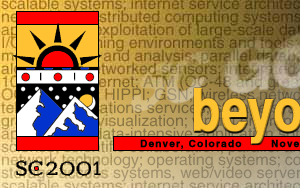 Dr. Chris Johnson delivered a plenary talk entitled "Scientific Visualization: Bridging the Complexity Threshold" at this year's Supercomputing conference in Denver, Colorado. Dr. Johnson discussed the need to bridge the "complexity threshold" in order to develop useful applications for analyzing data. He reviewed the state-of-the-art in visualization techniques, their use in real world applications, and presented an outline for future visualization research.
Dr. Chris Johnson delivered a plenary talk entitled "Scientific Visualization: Bridging the Complexity Threshold" at this year's Supercomputing conference in Denver, Colorado. Dr. Johnson discussed the need to bridge the "complexity threshold" in order to develop useful applications for analyzing data. He reviewed the state-of-the-art in visualization techniques, their use in real world applications, and presented an outline for future visualization research.Supercomputing 2001 Plenaries




